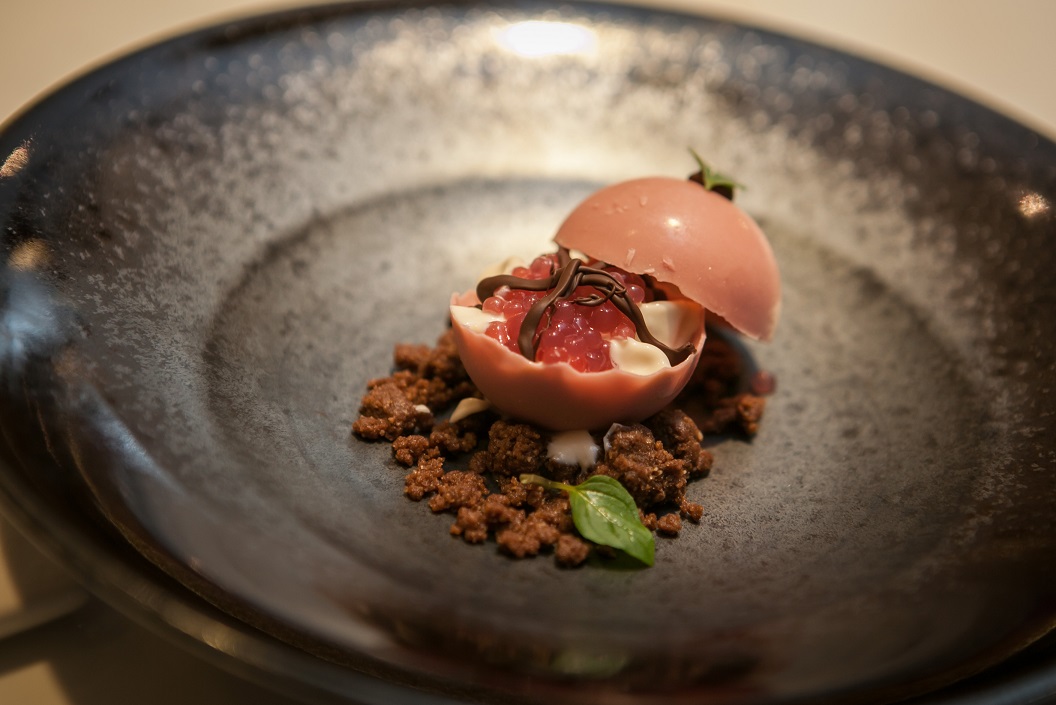 The pomegranate caviar in Belgian chocolate attempts to mimic the look and taste of the pomegranate fruit. – Pic by Magnum, January 28, 2016. Plumes of thick white smoke float out of the kitchen. It's not a fire, it's just chef Isadora Chai making an espresso sorbet with liquid nitrogen, one of the many cool things one can do with molecular gastronomy.
The pomegranate caviar in Belgian chocolate attempts to mimic the look and taste of the pomegranate fruit. – Pic by Magnum, January 28, 2016. Plumes of thick white smoke float out of the kitchen. It's not a fire, it's just chef Isadora Chai making an espresso sorbet with liquid nitrogen, one of the many cool things one can do with molecular gastronomy.
Molecular gastronomy is a type of science that looks at the physical and chemical properties of food, and how it transforms in the cooking process.
“Molecular gastronomy is an amalgamation of science and culinary,” Chai said at a recent Magnum event introducing their new pink and black ice cream.
“It's about adapting very precise measurements, temperature and pH levels,” she added, as she prepared a variety of solutions to make delicious pomegranate caviar, another molecular marvel.
Chai herself has a scientific background having graduated in biotechnology and biochemistry from Sydney, Australia.
In a process called spherification, she mixes pomegranate juice with algin, a kind of thickener which she then transfers into piping bag. Slowly and carefully, she squeezes droplets into a calcium water mixture to form globules that have the texture of roe and the flavour of pomegranate.
With the caviar, Chai puts together a delectable chocolate dessert that resembles and tastes like a pomegranate fruit.
What she has essentially done is deconstruct the pomegranate and reconstruct it in a different form.
“Deconstruction is a subset of molecular gastronomy.
“It pulls apart ingredients and flavours of a familiar food and puts it back together in a different and new way,” she explained.
Other molecular methods include dehydration, a technique that Chai employs in her restaurant, Bistro à Table in Section 17, PJ.
One way of using it involves dehydrating foam to form a thin wafer. She uses dehydrated milk foam wafers to mould into the shape of a bird to use as part of a dish.
Chai lets on that the molecular work is tedious and time consuming, often taking hours to craft one dish.
“The probability of making something great is not that high actually,” she admitted.
“My staff and I will ruin like five things before we get one perfect.”
Chef Isadora Chai assembles her deconstructed pomegranate with Belgian chocolate and pomegranate caviar. – Pic by Magnum, January 28, 2016. While the processes in molecular gastronomy can put on an impressive show, Chai feels that the Malaysian market is still not as adventurous in trying it out.
“The market is very small and demand is very small.
“It's an experience but Malaysians are very conservative. We all fall back to the comfort foods like chee cheong fun and chicken rice,” she said.
Molecular gastronomy is also an expensive investment on the restaurant's part, Chai said.
“It does cost a lot of money and investment to have the facilities to offer molecular work,” she said, adding that a liquid nitrogen tank which will only last one to two years can cost RM5,000.
Despite that, Chai thinks chefs will continue to incorporate molecular techniques into their cuisine.
Apart from her own restaurant, Bistro à Table, Chai recommends chef Frederico Mechieletto's creations at Marini's on 57 for those who are interested in a taste of molecular gastronomy. – January 28, 2016.

Comments
Please refrain from nicknames or comments of a racist, sexist, personal, vulgar or derogatory nature, or you may risk being blocked from commenting in our website. We encourage commenters to use their real names as their username. As comments are moderated, they may not appear immediately or even on the same day you posted them. We also reserve the right to delete off-topic comments